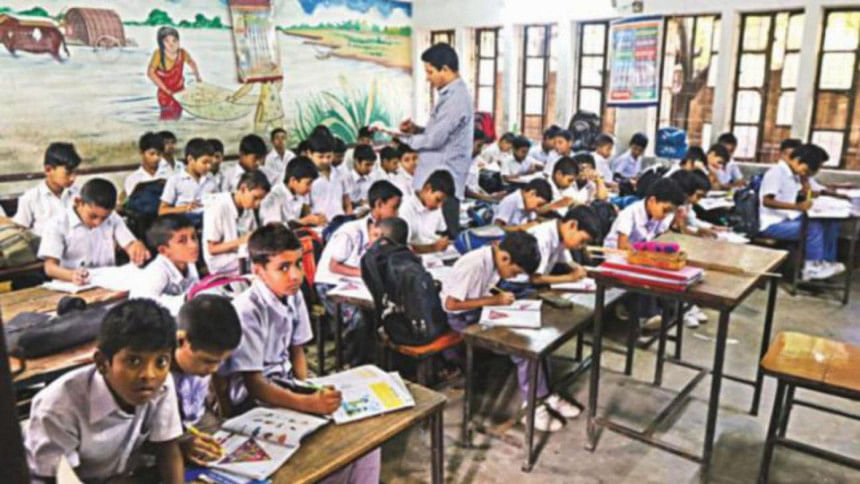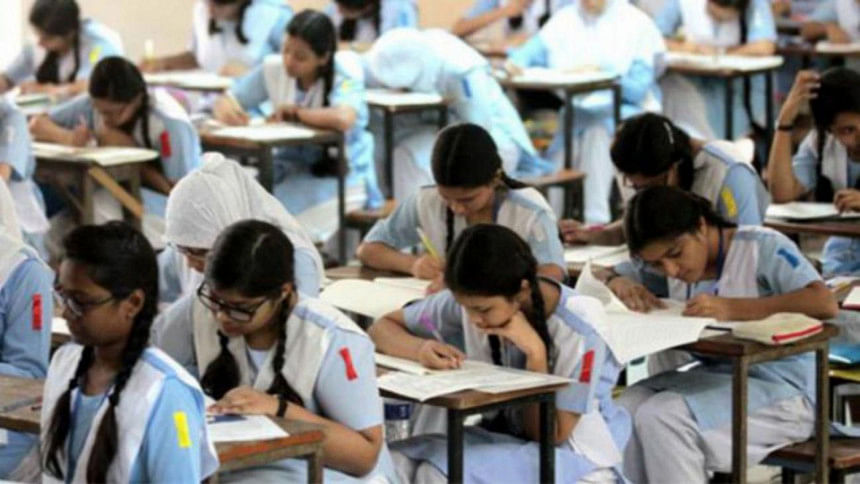Jobs and hope for the future

“Is it a problem of not enough jobs in the national economy, or not enough people with the right skills for them?” This is a question that is often asked, but looking at only one side of the coin provides a partial or even misleading answer. Besides jobs and skills, young people also want to look at the future with hope, confidence and pride in their country.
THE PROMISES OF THE NEW GOVERNMENT
One of the 21-point election pledges of the Awami League, the winners in the 2018 national parliamentary election, is about youth. With the motto “Power of Youth: Prosperity of Bangladesh,” the party's promise is to transform youth into an organised, disciplined and productive force. Youth is seen as the driving energy for fulfilling the dream of “Shonar Bangla” and building “the digital Bangladesh” (Awami League Manifesto, 2018).
The specific agenda for action emphasises creation of jobs, expansion of education and training, incentives for self-employment, and improving the morale of youth through healthy entertainment and sports.
To create youth employment, the national service programme (offering a public service job to an educated young person from each family) will be extended to all upazillas. It has been promised that 12.8 million jobs for young people would be created in five years. From each upazilla, on an average, one thousand young men and women would be helped to secure jobs abroad.
Youth training centres will be established in each upazilla. An integrated database of all young people with low, middle and high level of education will be prepared. The scheme of low-interest and no-security loan of two lakh taka will be expanded to encourage entrepreneurship and self-employment. A “youth entertainment centre” in each upazilla and a “youth sports complex' in each district will be established (Ibid).
The pre-election promises show the importance given to the role of youth and the need to create the conditions for them to make their contribution. However, the items listed, each one justifiable in their own right, needs to be part of a holistic approach to strengthening the role and contribution of youth in transforming society and the national economy.
Some salient facts from the Labour Force Survey 2017 need to be noted (BBS, 2018).
Of the 63.4 million economically active population over 15 years, 47 million or three quarters are categorised as youth.
The unemployment rate is estimated to be 4.3 percent, but underemployment and low wages below subsistence level were not reported. Young people not in employment or training, including graduates seeking appropriate jobs, were not fully represented in this number.
Eighty-six percent of the total employed population aged 15 and above was in the informal sector—not under the purview of labour regulations, but it provided livelihood for the vast majority of the population, and kept the economic wheels of the country turning. But it is characterised largely by low skills, low productivity and low earnings of workers.

Technical and vocational education and training (TVET) also are not specifically geared to the informal economy jobs. TVET is provided by over 13,000 training centres in the public and private sectors. About 1.3 million people received training on 87 trades in the country in 2017.
Interestingly, the labour force is estimated to be growing at a rate of 1.3 million per year, about half of whom are women. While the number of trainees in training centres match the growth of the labour force, employers report shortage of skilled workers and young people remain without a job.
The Skills Development Policy, 2011 seeks to promote a coordinated effort to contribute to attaining the country's middle-income status. The policy intends to promote internationally comparable skills for all potential workers, male and female. The aim is also to expand services for the disabled and socially excluded and workers for small and medium-sized enterprises. Enhancing resources for skills development for both domestic and international markets is emphasised.
The implementation of the 2011 policy, with the aim of promoting a coordinated skills development effort, has itself been uncoordinated and slow. The efficiency and effectiveness of actions taken have not been satisfactory. The expansion of activities which are included in the election pledges can bear fruit only if their quality and effectiveness can be ensured with stronger management, monitoring and accountability.
It is widely recognised that the profile of jobs and skills required for workers will be very different by 2030 from those of today; and that there is at present huge unemployment and underemployment among youth arising from the mismatch between skills and jobs. But the strategy anticipated seems to be of expanding TVET that exists and raising the proportion of secondary students, including madrasa students, in TVET, though a workable and effective model for this purpose has not emerged.
All evidence suggests that expanding the programmes we have now will not prepare students to be productive and capable workers that the market demands. So the mere expansion of the current programme cannot be the answer. Moreover, the current programmes do not even begin to serve the needs of workers in the informal economy, for which no coherent strategy and plan for skill development exist, but which absorbs over 80 percent of workers.
Diverse skills formation opportunities, which are market responsive, with a strong private-public partnership approach, are needed. The emphasis has to be on ensuring quality and relevance rather than just expanding existing institutions and programmes.

THE DEFINING CONCEPTS
A number of concepts or terminologies has come into vogue which highlight certain aspects of the complex challenges of offering young people jobs, skills, hope and a sense of pride about the future and the country.
NEET: A term that is a descriptor of a large proportion of young people is “Not in Education, Employment or Training,” or NEET in short. An ILO survey (“Decent Work Decade 2006-2015: Asia-Pacific and the Arab States”) reported that 40 percent of young people aged between 15 and 24 in Bangladesh fell in this category. The absolute number added up to about 12 million—two-thirds females.
It is a situation that young people are in not by choice. They would rather be enrolled in an educational institution or be employed in a job that offers a living wage. It is not a situation that fills them with self-confidence or pride about themselves. Drug, delinquency and attraction to extremism are the fallout of this situation.
Jobless Growth: Related to the NEET phenomenon is the change in structures of the economy and development of technology including ICT which have changed the nature of the contribution of labour in the economy. The impact has been particularly negative for young first-time entrants to the labour force.
Between 2013 and 2016-17, the average annual GDP growth was 6.6 percent, but the growth of jobs during this period was only 0.9 percent. The employment share of the manufacturing sector actually declined from 16.4 percent to 14.4 percent. This added up to a decline in manufacturing jobs of 0.77 million. More alarmingly, female employment declined by 0.92 million (Bangladesh Labour Force Survey cited by SANEM, 2018).
High annual real GDP growth rate of over 6 percent during the past decade has not been accompanied by sufficient economic diversification that would enhance employment opportunities (SANEM, 2018).
Demographic dividend: It is the phenomenon of economic benefit derived from a high proportion of working age population (15 to 60 years) compared to the non-working age population. Bangladesh is passing through its phase of demographic dividend, which is expected to last up to around 2030.
The current population composition of Bangladesh, in spite of recent decline in fertility rate, is shaped by past high
population growth—people born in the past coming of age now and entering the work force.
Thus the ratio of the non-working age population (under age 15 and over age 60) dependent on the earning of the working age population—also known as the dependency ratio—is relatively low.
The high dependency ratio in the more advanced economies as well as in oil reach countries have created opportunities for overseas employment for our workers. The catch is that deriving the advantage of demographic dividend requires appropriate skills and capabilities of workers. Low skills lead to low productivity and low earnings for our workers both at home and abroad.
Another emerging risk is the broader impact of new technology that calls for new kinds of skills and reduces opportunities for traditional jobs. The impact of automation and digital technology has brought about what is known as the Fourth Industrial Revolution.

The Fourth Industrial Revolution: Successive phases of industrial progress, each phase described as a revolution, began in the 18th century with the harnessing of steam power for mechanical operations in manufacturing, which was followed by the use of electricity and assembly line production in the 19th and the 20th century, and the spread of information and communications technology in the last quarter of the 20th century. The fourth phase of industrial revolution began at the dawn of the 21st century with the transformation of digital technology through artificial intelligence, robotics, Internet of Things (IOT) and quantum leap in computational power.
Md Mushfiqur Rahman, Project Director of Access to Information in the Division of Information and Communication Technology, noted that over 50 million jobs may be lost due to automation in the next two decades in five major sectors of the economy—garments, furniture, agro-processing, tourism, and leather. This global trend would also lead to loss of blue-collar jobs overseas for Bangladeshi workers (The Daily Star, 13 January 2019.)
There can be a positive synergy between Demographic Dividend and the Fourth Industrial Revolution and the risks averted only if the youth, especially the new entrants into the working population, can be provided with appropriate skill sets in the next five to ten years.
The Post-Millennial Generation: It is the generation of young people who were born around and after the turn of the century and is now coming of age. They will be the mainstay of the work force and from them will arise the leadership for all spheres of national development. How the nation fares in the course of transition to a developed and prosperous country depends on how this generation is nurtured in respect of capabilities, skills, attitudes and values.
The opportunities and challenges of the new industrial revolution and the demographic dividend define the life prospects of the post-millennials. They are particularly vulnerable to the adverse effects of NEET and jobless growth.
The sheer chance of birth—socio-economic status, gender, geography, ethnicity, religion and language of a person at birth—is the greatest source of inequality in society. Those born with greater advantages also can exploit better the opportunities of life. Digital technology, for instance, is more accessible to the ones who are fortunate by birth, aggravating further the inequality that already exists. Overcoming these sources of inequality is the greatest challenge of social ethos and public policy in a modern and democratic society.
AN INCLUSIVE VISION SHARED BY YOUTH
Speaking at the Digital Leaders' Policy Meeting on Jobs at the 2017 World Economic Forum in Davos, Switzerland, Prime Minister Sheikh Hasina presented a bold and forward-looking vision for the future on the skills and jobs front. She said Bangladesh wanted to expose millions of its youths to the most advanced technologies, knowledge, and skills. “Our aim is to bridge the knowledge and technological gaps within our societies, as well as with the outside world,” she said.
The Prime Minister said Bangladesh would continue to have a youthful population for at least the next three decades. In terms of strategy, she stated that Bangladesh is employing technology and related knowledge solutions to: i) enhance human capital and skills; ii) deliver critical services effectively; and iii) create the right synergies between knowledge, skills, and employment (Asian Age, January 21, 2017).
Speaking of the essential elements of the political vision—Vision 2021 (graduating to the middle-income country status) and Vision 2041 (becoming a developed nation), the prime minster said that the government was assessing the changing patterns of work, analysing the market situation, and prioritising skills development by dynamically linking these with manufacturing and service industries. An “inclusive” approach embracing formal and informal sectors and the disadvantaged groups across the economy was to be pursued, she said.
Commenting on the unfulfilled promises of the neoliberal faith in globalisation and disgruntlement of citizens in many countries, the Nobel Prize winning economist Joseph Stiglitz pleaded for a Green New Deal. He was invoking the post-World War II New Deal initiated by Franklin Roosevelt in USA, emphasising the overwhelming urgency of climate change.
“The Green New Deal” according to Stiglitz, “sends a positive message of what government can do, for this generation of citizens and the next. It can deliver today what those who are suffering today need most—good jobs. And it can deliver the protections from climate change that are needed for the future … The Green New Deal will have to be broadened … where many ordinary citizens lack access to good education, adequate health care, or decent housing.”
Stiglitz writes, “The grassroots movement behind the Green New Deal offers a ray of hope to the badly battered establishment: they should embrace it, flesh it out, and make it part of the progressive agenda. We need something positive to save us from the ugly wave of populism, nativism, and proto-fascism that is sweeping the world” (Stiglitz, 2019).
As Prime Minister Sheikh Hasina anticipates, jobs and skills for youth must be made part of a larger vison of sustainable and inclusive development that young people can espouse and help to build.
Manzoor Ahmed is professor emeritus at BRAC University.
References
Awami League (2018). “Election Manifesto,” Item 3.11. Dhaka.
BBS (2018). Bangladesh Labour Force Survey 2017. Dhaka: Bangladesh Bureau of Statistics.
ILO (2017). “Decent Work Decade 2006-2015: Asia-Pacific and the Arab States,” Geneva: International Labour Organisation
Raihan, S (2019). “Labour market and employment challenges in Bangladesh in the context of SDGs,” SANEM: Thinking Aloud, 5:8. January, 2019. Dhaka: South Asia Network of Economic Modelling.
The Daily Star (2019). Fourth Industrial Revolution: Migrant workers' jobs at stake.” 13 January, 2019.
Asian Age, January 21, 2017
Stiglitz, J (2019). “From Yellow Vests to the Green New Deal” Daily Star, 10 January, 2019

 For all latest news, follow The Daily Star's Google News channel.
For all latest news, follow The Daily Star's Google News channel. 



Comments